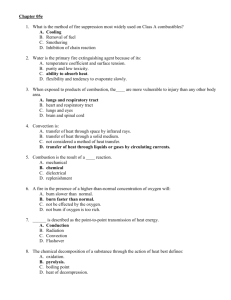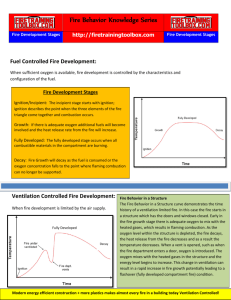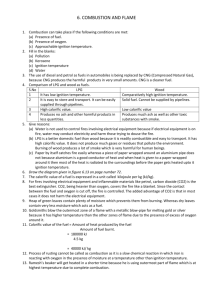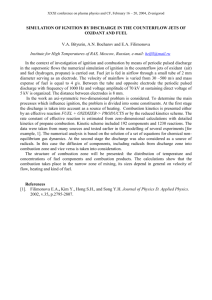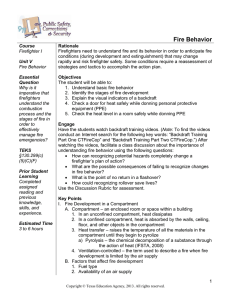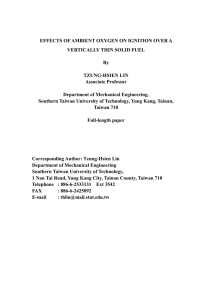Fire Protection Fundamentals
advertisement
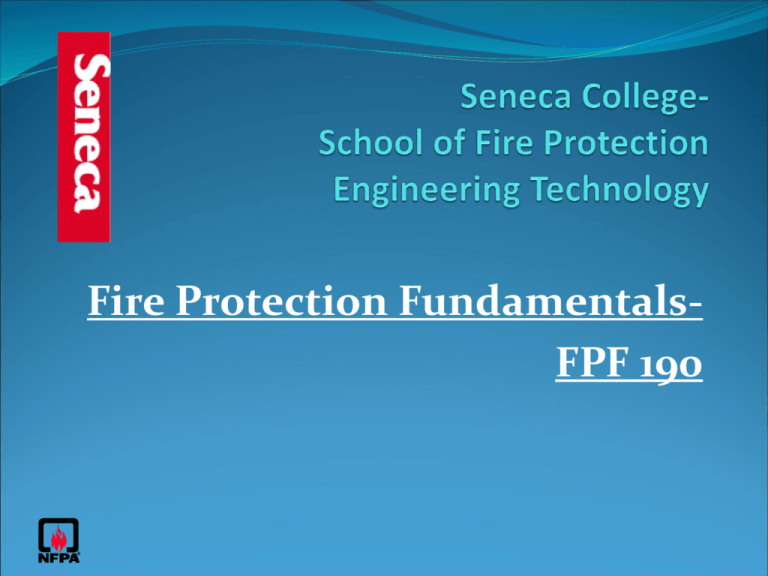
Fire Protection FundamentalsFPF 190 Learning Objectives Explain basic fire chemistry Explain the differences between the fire triangle and the fire tetrahedron Understand fire chemistry and fire behavior terms Explain the difference between heat and temperature Describe the three methods of heat transfer Understand ignition methods and sources Explain the stages of fire and the products of combustion Illustrate classifications of fire Explain the ways to control, limit and suppress fires and explosions © 2004 National Fire Protection Association 3 Chemistry of Fire Fire - a rapid oxidation process with the evolution of light and heat in varying intensities. Fire is an exothermic reaction (energy is released). Flaming fire is always a gas phase (gas - gas) reaction meaning one or more ignitable gases are combining with a gaseous oxidizing agent in the flame zone forming new compounds. © 2004 National Fire Protection Association 4 Fire Triangle Fuel Oxygen Heat © 2004 National Fire Protection Association 5 Fire Tetrahedron © 2004 National Fire Protection Association Fuel Heat Oxidizer Uninhibited (self-sustaining) chemical chain reaction 6 Uninhibited Chemical Chain Reaction A chemical process yielding products able to act as initiators for other reactants, leading to further reactions of the same kind. © 2004 National Fire Protection Association 7 Elements of Chemical Reactions Oxidation Interaction between fuel and oxidizer Self-Sustaining Reaction Provides enough energy to continue reaction Exothermic Reaction Gives off more energy than is consumed Smoke-Producing Process Smoke is broad term for all products of combustion © 2004 National Fire Protection Association 8 Fire Terminology Heat Release Rate (HRR) - The amount of heat energy released by combustion expressed in Btu/sec or kilowatts (kW). The HRR of a combustible is related to its chemical makeup, physical form and the quantity of oxidant present. Ignition temperature - The minimum temperature to which a substance must be heated in air to ignite independently of the heating source. This temperature is sometimes referred to as the auto-ignition temperature. This temperature is derived from specific laboratory testing of pure substances and serves to classify the hazard presented by the ignitable liquid. The actual ignition temperature of most substances may be somewhat higher than those reported in laboratory tests. © 2004 National Fire Protection Association 9 Fire Terminology Oxygen - A nonflammable (oxidizing), gaseous element that is colorless, tasteless and odorless. It is found in a free state in the atmosphere where it makes up 21% of atmospheric air. Oxygen combines with virtually all the other elements except the inert gases. Periodic Table symbol: O. Oxidation - Oxidation is generally considered any reaction in which electrons are transferred. The substance that gains electrons in the reaction is considered the oxidizing agent and the substance that loses electrons is the reducing material. Oxidation and reduction always occur simultaneously. Compounds containing oxygen, chlorine, fluorine, etc. are common oxidizing agents. Compounds such as potassium nitrate, potassium perchlorate, and calcium hypochlorite are examples of oxidizers commonly encountered in explosive and incendiary compositions. © 2004 National Fire Protection Association 10 Fire Terminology Gas Chromatography - Flame Ionization Detector (GC - FID) - A laboratory test method which vaporizes mixtures by heating and then separates the individual components according to their boiling points and molecular weights. For each component present in a sample, the detector produces a signal proportional to the quantity of that component. The resulting visual graph is called a chromatogram. Pyrolysis - Transformation of a compound into one or more substances by heat alone. This process often precedes combustion. © 2004 National Fire Protection Association 11 Characteristics and Behavior of Fire Heat and Temperature are not the same… Heat- measure of the quantity of energy contained by a material Temperature- indication of the level of energy Heat and Temperature Units Temperature Units: Celsius Fahrenheit Kelvin Rankine Heat Units: • Joule • Watt = 1 joule/sec. (kilowatt kW = 1000 watts) • Calorie • British Thermal Unit (BTU) Heat Transfer Conduction Through or within a material as result of physical contact Convection Due to movement of a fluid Radiation By electromagnetic waves © 2004 National Fire Protection Association 14 Conduction © 2004 National Fire Protection Association 15 Convection © 2004 National Fire Protection Association 16 Radiation © 2004 National Fire Protection Association 17 Sources of Ignition Four types Chemical Electrical Mechanical Nuclear Explosions Detonations- propagate at the speed of sound producing a shock wave Deflagrations- propagate at less than the speed of sound Types of Explosions Chemical Mechanical Atomic Thermal © 2004 National Fire Protection Association 19 Products of Combustion Fire Gases Carbon Monoxide (CO) Carbon Dioxide (CO2) Hydrogen Cyanide (HCN) Hydrogen Chloride (HCl) Flame Heat Flammability Properties of Fuels Gas phase fuels Liquid fuels Solid fuels © 2004 National Fire Protection Association 21 Classification Based on Fuel Type Class A- ordinary combustibles- wood, paper, cloth, rubber, etc. Class B- flammable and combustible liquidsgasoline, diesel fuel, solvents, lacquers, etc. Class C- energized electrical equipment- operating saws, drills, transformers, etc. Class D- combustible metals- magnesium, titanium, zirconium, sodium, lithium, potassium Class K – fire in cooking appliances that involve cooking media © 2004 National Fire Protection Association 22 Types of Fires Diffusion flame Candles, most natural fires Premixed flame gas furnace Smoldering fire Glowing embers © 2004 National Fire Protection Association 23 Stages of Fire Growth and Spread Preignition Ignition (incipient) Growth (free burning) Fully developed Decay (burnout) © 2004 National Fire Protection Association 24 Incipient- ignition stage Instantaneous to several hours Typically controlled by fuel and heat source Still small enough for fire extinguisher © 2004 National Fire Protection Association 25 Growth Additional fuel ignites Series of ignitions How quickly flame can heat additional fuel-only limit Conditions become life threatening © 2004 National Fire Protection Association 26 Fire Growth- 2 t curves Standard Time-Temperature Curves- t2 fires- Fire Growth Four Standard t2 Fires 1000 800 Heat Release Rate (kW) 600 slow 400 medium fast 200 ultra-fast 0 0 100 200 300 time (s) © 2004 National Fire Protection Association 400 500 600 27 Preflashover, flashover, post flashover, backdraft Preflashover Flashover Postflashover Backdraft © 2004 National Fire Protection Association 28 Preflashover, flashover, post flashover, backdraft © 2004 National Fire Protection Association 29 Fire and Explosion Control Removal of heat Examples Use of water Removal of fuel Turn off gas, remove Removal of oxygen Inhibit chemical chain reaction brush, trees, etc. Put lid on flame, use CO2 Use clean agents, dry chemicals © 2004 National Fire Protection Association 30 Effects of Fire Products of Combustion: Products of complete combustion vs. products of incomplete combustion Other products of combustion: soot or tar © 2004 National Fire Protection Association 31 Conditions That Threaten Life Safety Thermal injury Toxicity Asphyxiation Obscuration © 2004 National Fire Protection Association 32 Summary Explained basic fire chemistry Explained the differences between the fire triangle and the fire tetrahedron Described the effects of oxygen, fuel and heat on fire Understood the many terms in fire behavior Described the three methods of heat transfer Understood ignition methods and sources Explained the stages of fire and the products of combustion Illustrated classifications of fire Explained the ways to control, limit and suppress fires and explosions © 2004 National Fire Protection Association 33 Review Questions 1. 2. 3. 4. 5. 6. What three things are required for a fire? What two elements provide the components for the chemical reaction to occur? How must the fuel and oxidizer be mixed? When does piloted ignition occur? What are the three methods of heat transfer? List the five classifications of fire based on the type of fuel burning. © 2004 National Fire Protection Association 34 Answer Key to Review Questions 1. 2. 3. 4. 5. 6. Fuel, oxygen, and heat The fuel and the oxidizer They must be intimately mixed. Ignition that occurs in the presence of intense heat source such as an arc, spark, or flame. Conduction, convection, and radiation The most common classification system depends on type of fuel burning and gives a general indication of the hazards involved. This system uses letters to designate the fuel type: A, B, C, D, and K. © 2004 National Fire Protection Association 35 Additional References NFPA’s Building Fire Safety Systems video NFPA’s Fire: Concepts and Behavior video © 2004 National Fire Protection Association 36


